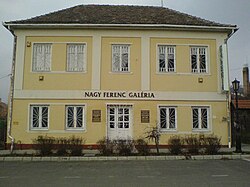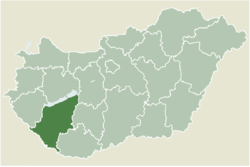Tab, Hungary
Tab | |
|---|---|
 Ferenc Nagy Gallery in Tab | |
 Location of Somogy county in Hungary | |
| Coordinates:46°43′58″N18°02′08″E/ 46.73271°N 18.03556°E | |
| Country | |
| Region | Southern Transdanubia |
| County | Somogy |
| District | Tab |
| RC Diocese | Kaposvár |
| Market town | 1847 |
| Area | |
| • Total | 25.86 km2(9.98 sq mi) |
| Population (2017)[2] | |
| • Total | 4,307[1] |
| Demonym | tabi |
| Time zone | UTC+1(CET) |
| • Summer (DST) | UTC+2(CEST) |
| Postal code | 8660 |
| Area code | (+36) 84 |
| Patron Saint | Saint Stephen |
| NUTS 3 code | HU232 |
| MP | Mihály Witzmann(Fidesz) |
| Website | Tab Online |
Tab(German:Tabau) is a town inSomogy County,Hungary,and the seat ofTab District.It is situated approximately 175 km South West ofBudapestand 22 km fromLake Balaton.
History
[edit]Tab was first mentions asvilla Thobin an official document from 1211. In 1320 the settlement belonged to a church dedicated toSaint Peter.Between 1285 and 1386 it was in the hands of theUgalifamily under the nameThob.Their surname had been eternalized by the medieval village ofUgajpusztawhich is now part of Tab. Later the settlement belonged toIstván Rozgonyi,theispánofBakonyand his wife,Cecília Szentgyörgyibetween 1428 and 1435. In 1438 theBatthyányandFajszfamilies owned it. Before theTurkish occupationit belonged toLászló EwleweldiandDemeter Tharródy.
It was first attacked by the Turks in 1542, but it fell finally later between 1551 and 1553. Then Tab became part of theNahiyeofTörökkoppány.Most of its residents died or fled to other parts of the country, some moved into the woods and swamplands. According to the tax registration of theOttoman Portebetween 1573 and 1574 there were 12 tax payer households in Tab. There were occasionally fights between the Hungarian and Turkish forces.Ferenc NádasdyandGyörgy Zrínyiwith the papal garrisons attacked once theAghaof Törökkoppányand chased the Turks away for a short time.
After theLiberation of Budain 1689 Tab became part of theHabsburg Empire.Several noble families (e.g.Fajszky,Mérey,Lengyel,Nyitray,Gussits,Nagy de Felsőbükk,Révayetc.) who had previously lands here reclaimed them, therefore they moved into the villages near Tab.
It is known from the census of 1715 that Tab welcomed Hungarians, Germans and Slovaks from 1712 on in larger numbers. Tab had one of largest Jewish communities in Somogy County which is also proven by the fact that one of the most prestigious synagogue ofSomogy Countywas built here in 1762. Tab stood on none of the important national or international trade routes, but the local authorities thought that the settling of the Jewish community could have a strong impact on the economic development of the settlement. Between 1798 and 1800 with the financial help of theDiocese of Veszprémthe local church was restored and expanded. Its sanctuary and the nobles' oratorio was decorated by the fresco ofFranz Xaver Bucherin 1799. The church was built inBaroque stylehowever the main and side altars as well as the pulpit and the desks were made inRococo.
Tab became amarket townin 1847. In 1871 it was classified as the seat of its district. According to the 1853 census ofSomogy Countythe town had a population of 2,090 residents of which 973 wereHungarians(46.6%), 625Jews(29.9%), 428Slovaks(20.5%) and 64Germans(3.0%).[3]
At the end of the 19th century the town experienced a rapid development in infrastructure, trade and industry.Jakab Zuckermandelestablished a printhouse there.Ignác Pallósfounded a steam brick and tile factory which employed the labor of Tab and the surroundings every year from autumn until spring. The first newspaper of the town started in 1909 under the nameTab és Vidéke(English:Tab and its Region). In 1913 theOtthon Coffeehousestarted to project movies. A credit institute was founded. The sporting association of Tab was formed in 1914.
In theFirst World War754 people from Tab served as soldier. After the war the nuns of theSzociális Missziótársulatstarted beside religious and moral lessons for the younger and older generations also handcraft, housekeeping and nursing courses. In 1928 theNépművelő Testvérek Társaságacontinued their work. They established a kindergarten and a folk house. A new journal was founded under the nameNépapostolin 1930 which existed until 1933. There were three primary schools: a Catholic, a Lutheran and a Jewish.
In theSecond World Wara huge number of Polish refugees arrived to Tab. In March 1944 a ghetto was formed for the Jewish residents of Tab. The Soviets arrived on December 2, 1944.
Main sights
[edit]- Roman Catholic Church – as a famous fresco byFranz Xaver Bucher,a replica of theHoly Crown of HungarybyAlajos Erényiand a walled crypt (opened on June 10, 2007)
- Ferenc Nagy Gallery
- Welsersheimb Mansion
- Statue ofSaint Stephen of Hungary(2000)
Notable residents
[edit]
- Bernat Rosner(born 1932), Hungarian Holocaust survivor
- Norbert Pap(1969–), Hungarian geographer–historian, founder of the Balkan Research Group, leader of the Zrinski-Suleiman Research Group
- Samuel Miklos Stern(1920–1969), Hungarian-British Orientalist
- Ferenc Nagy(1920–1998), Hungarian woodcutter artist
- Gyula Takáts(1911–2008), Hungarian poet, author, translator, teacher
- Zeno Welser von Welsersheimb(1835–1921), Austrian Minister of Defence (1880–1905)
- Gerő Buzás(1904–1987), Hungarian Roman Catholic priest, author
International relations
[edit]Twin towns
[edit]References
[edit]External links
[edit]- Official websitein Hungarian
- Street map(in Hungarian)





